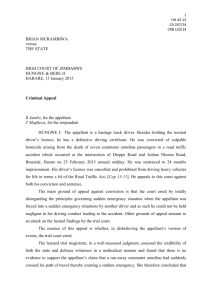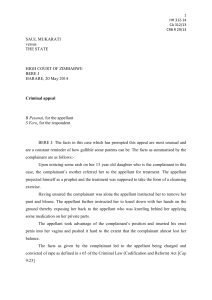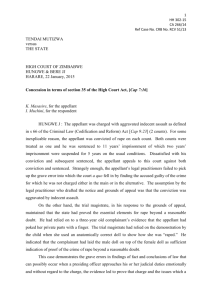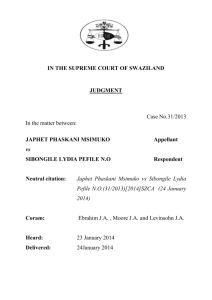36. nyambe mukena judgment 08 05
advertisement
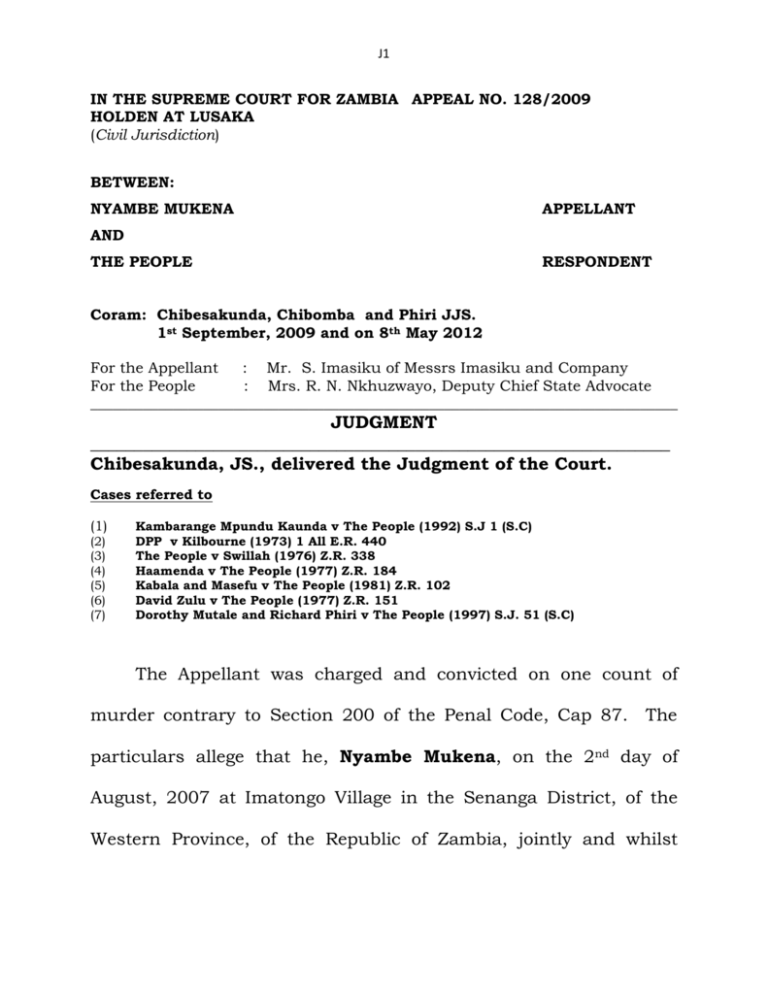
J1 IN THE SUPREME COURT FOR ZAMBIA APPEAL NO. 128/2009 HOLDEN AT LUSAKA (Civil Jurisdiction) BETWEEN: NYAMBE MUKENA APPELLANT AND THE PEOPLE RESPONDENT Coram: Chibesakunda, Chibomba and Phiri JJS. 1st September, 2009 and on 8th May 2012 For the Appellant : Mr. S. Imasiku of Messrs Imasiku and Company For the People : Mrs. R. N. Nkhuzwayo, Deputy Chief State Advocate ______________________________________________________________________________ JUDGMENT __________________________________________________________________ Chibesakunda, JS., delivered the Judgment of the Court. Cases referred to (1) (2) (3) (4) (5) (6) (7) Kambarange Mpundu Kaunda v The People (1992) S.J 1 (S.C) DPP v Kilbourne (1973) 1 All E.R. 440 The People v Swillah (1976) Z.R. 338 Haamenda v The People (1977) Z.R. 184 Kabala and Masefu v The People (1981) Z.R. 102 David Zulu v The People (1977) Z.R. 151 Dorothy Mutale and Richard Phiri v The People (1997) S.J. 51 (S.C) The Appellant was charged and convicted on one count of murder contrary to Section 200 of the Penal Code, Cap 87. The particulars allege that he, Nyambe Mukena, on the 2nd day of August, 2007 at Imatongo Village in the Senanga District, of the Western Province, of the Republic of Zambia, jointly and whilst J2 acting with other persons unknown, did murder one Kawama Sitwala. The evidence for the prosecution on which he was convicted is that PW1 and PW2, relatives of the deceased, Kawana Sitwali, on the 2nd August, 2007 woke up around 05:00 am. Both around that time saw a stranger moving in the vicinity of the house of the deceased. This stranger kept moving to and from the house of the deceased and to near the place the villagers used to use as a toilet. He was on the path leading to the toilets. At that time, the deceased was getting ready to go to the Boma. He was looking at his bicycle making sure that it was road worthy before his departure. PW1’s and PW2’s testimony is that they also were preparing to go to a funeral house in the nearby village. They both testified that they found this stranger to be a person they have never seen before. They observed that he kept standing and sitting down whenever he felt tired. According to PW1, she observed the man for three hours on the same spot. According to PW2, she even tried to go and chase him as he was a nuisance because he was in their way to the place they used as a toilet. Later, the deceased J3 started walking as he pushed his bicycle to the Boma. At that point in time, the stranger also then disappeared; the witnesses did not know where he went. Ten minutes later, they heard two gun shots. They went to the direction where the gun shots were coming from and found the deceased lying in a pool of blood with gun shot wounds. The two witnesses further informed the court that this stranger had stayed on the side of the path on which the deceased was walking to go to the Boma. PW1 identified at the identification parade, the young stranger as the Appellant. PW3, another villager, testified that on that same day, the 2nd August, 2007, in the morning, as she and others were in the bush collecting fire wood, they saw the deceased walking. He, after greeting them, informed them that he was proceeding on to the Boma. Soon after they parted with the deceased, they heard a bang which sounded similar to a tyre burst. After this bang, PW3 heard somebody crying three times that ‘I am dying’. She then heard a second bang. So she was scared. She and her two colleagues ran home, shouting for help. As they ran to the village, they met some villagers from the village and after that they reported this incident J4 to these people. They all decided to go where the sound was coming from. They then found the deceased already dead. PW6 was the arresting Officer. He testified that an identification parade was conducted at which PW1 identified the Appellant as the young stranger who she says she observed for three hours in the vicinity of the deceased’s house. The Appellant was found with a case to answer. He opted to remain silent. On this evidence before the court, the learned trial Judge convicted the Appellant and sentenced him to a mandatory sentence of death. He now is appealing against both conviction and sentence. At the hearing of the appeal, the Appellant raised three grounds of appeal namely: Ground 1 The learned Court below erred in law and fact when it convicted the Appellant on the uncorroborated evidence of PW1 and PW2, both being J5 witnesses with an interest to serve or witnesses whose evidence was suspect. Ground 2 The learned Court below misdirected itself by not considering the possibility of honest mistake in the evidence of identification Ground 3 The learned Court below erred in law and fact when it convicted the Appellant in the absence of direct evidence connecting the accused to the crime. On ground 1, it was argued on behalf of the Appellant that the lower court erred in law and in fact when it convicted the Appellant on uncorroborated evidence of PW1 and PW2, both being witnesses with an interest to serve or witnesses whose evidence was suspect. Elaborating on this argument, Counsel argued that although it is trite law that a court may convict on the evidence of one witness alone, however, in practice, it has been established that in certain types of cases or with particular categories of witnesses, it is dangerous to convict in the absence of corroboration, see the case J6 of Kambarange Mpundu Kaunda v The People1. Counsel argued that PW1 and PW2 whose evidence the court heavily relied on in convicting the Appellant, fell within the category of what may be described as suspect witnesses as the two witnesses were both close relatives of the deceased. As such, their evidence should have essentially been treated as suspect particularly in the absence of corroboration. Counsel cited an English case of DPP v Kilbourne2 where Lord Hailsham pointed out that the principles regarding the categories of suspect witnesses must be applied to a witness with a possible bias such as a relative. The question in every such case is whether the danger of relying on the evidence of the suspect witness has been excluded. According to Counsel, critical consideration is not whether the witness does not in fact have an interest or purpose of his own to serve but rather whether he is a witness who may have a motive to give false evidence. On the facts at hand, Counsel argued, PW1 and PW2 were witnesses with a possible motive of punishing any person they believed to have caused the death of their relative. He, therefore, urged the court to uphold this ground of appeal. J7 On ground 2, Counsel argued that the lower court misdirected itself by not considering the possibility of an honest mistake in the evidence of identifying the Appellant as the person who murdered Kawana Sitwala. He argued that at law, the identification evidence is normally considered with special care to ensure that a person is not wrongly convicted on false or mistaken evidence of identity. According to the case of The People v Swillah3, a court must all the time consider the danger of an honest mistake. Counsel explained that in the case of Haamenda v The People4, some guidelines on the approach to be taken were propounded. Firstly, that the Judge should warn himself or herself of a special need for caution before convicting the accused in relying on the correctness of the identification. Secondly, the Judge should examine closely the circumstances in which the identification by each witness was made. In the case before the Court, Counsel urged the court to address itself to these requirements. Counsel argued that PW1 for instance stated that she observed the young strange man for a period of three hours before disappearing and that it was her first time to see this person in the village. Counsel contended that that period in which PW1 alleged to have observed the Appellant is J8 rather long considering her evidence as to the time of her waking up and hearing of the gun shots. In Counsel’s view, the period of observing the young strange person must have been less than three hours before the gun shots were heard. Thirdly, according to the testimony by both PW1 and PW2, the young stranger stood at the distance of 75 metres from where they were. The question, therefore, is whether the observation made by both of them on the material day and PW1’s subsequent identification of the Appellant at the Police Station, was reliable. Counsel’s contention is that PW2’s testimony should not have been considered as credible taking into account the distance between where she was and where the young strange man was standing. PW1 could not have had a proper view of the young stranger. Counsel also argued that in fact, the identification parade took place several weeks after the event to the extent that, that should negate her ability to have had an accurate identification and as such, the possibility of an honest mistake. Counsel also attacked the way the identification parade was conducted. So, he urged the court to consider the quality of the evidence of identification as he labeled it as poor. Citing the case of Kabala and Masefu v The People5, he argued that the sole J9 objective of taking an identification parade is to test the ability of a witness to pick out a person he claims to have previously seen on a specified occasion. Counsel further argued that it is trite law that the identification parade must be fairly and properly conducted, failing which such evidence of identification would be of no use as evidence. He argued that according to the evidence on record, on the day of identification parade, PW1 and PW2 and Siwamba Nambai were all put in the office of the Officer-in-Charge. PW1 was the first witness to be called to the identification parade after which she was taken back to the office of the Officer-in-Charge where other witnesses yet to be called to the identification parade, were. The evidence on record also indicates that the Appellant had complained to the Police that he had been seen by PW1 outside the office of the Officer-in-Charge before the identification parade was conducted. Counsel’s contention is that the evidence of identification on which the court relied in convicting the Appellant was poor and thus not sufficient to connect the Appellant with the commission of the crime charged. J10 On ground three, Counsel argued that the court below erred in law and in fact when it convicted the Appellant in the absence of direct evidence connecting the accused to the crime. Counsel argued that the court below relied on circumstantial evidence. As a general rule, the court is competent to convict on such evidence if the possible defects in the circumstantial evidence may include not only those defects which occur in direct evidence such as falsehood, bias or mistake on the part of the witnesses, but will have the effect of erroneous inference. Citing the case of David Zulu v The People6 where it was held:“……the possible defects in circumstantial evidence may include not only those which occur in direct evidence such as falsehood, bias or mistake on the part of witnesses, but also the effect of erroneous inference… It is therefore incumbent on a trial judge that he should guard against drawing wrong inferences from the circumstantial evidence at his disposal before he can feel safe to convict. The judge in our view must, in order to feel safe to convict, be satisfied that the circumstantial evidence has taken the case out of the realm of conjecture so that it attains such a degree of cogency which can permit only of an inference of guilt.” He argued that in the case before this court, the inference of guilt was not the only reasonable inference because (a) there was no direct evidence or eye witness, (b) there was time lag between the time when the deceased left his house and the sound of gun shots at least ten minutes which can bring in the possibility that the J11 deceased was killed by unknown persons. Because of these two reasons, this left the case for the prosecution in speculation. Counsel pointed to further weakness in the prosecution’s case that none of the key witnesses saw the strange young man with any gun and yet the medical report established that the deceased died of a perforating gunshot wound in the skull. But the learned trial Judge did not consider all these weaknesses in the evidence of the prosecution. Citing the case of Dorothy Mutale and Richard Phiri v The People7, Counsel argued that where two or more inferences are possible, it has always been a cardinal principle of criminal law that the court will adopt the one which is more favourable to the accused. He, therefore, urged this court to uphold the appeal as the evidence before the court did not succeed in taking this matter out of the conjecture. This appeal should be allowed. Mrs. R. N. Nkhuzwayo for the People submitted that she did not support the conviction. According to her, there was no sufficient evidence to connect the Appellant to the commission of the offence. J12 We have looked at the evidence on the record. We have also considered issues raised in this appeal. We have addressed our minds to the authorities cited in particular, the case of David Zulu7 which has set useful guidelines in cases where the prosecution relies on circumstantial evidence. The question now is, did the learned trial Judge draw a wrong inference? Firstly, we have taken judicial notice of the village set-up. In a village set-up, visitors to the village are either known to the villagers or if they are strangers, their purpose to visit becomes evident fairly soon after arrival. This is because a village is usually a small entity and usually, consisting of one family or close members of the family. According to the evidence before this court, the young stranger who was later identified as the Appellant by PW1, visited the village at a rather ungodly hour around 05:00 hours in the morning without knowing the purpose of his visit and the people he was visiting. attracted the attention of both PW1 and PW2. That This stranger, further attracted the attention of the two witnesses because he was hovering around the deceased’s house. According to PW1, it took three hours. It has been argued by the Appellant that both PW1 and PW2 could not have seen this Appellant as he was about 75 J13 metres from where they were. We take judicial notice of the weather in August in Zambia. We also take judicial notice of the fact that 05:00 hours in the morning in August would be bright and clear to the extent that a person can easily see another person at a distance of 75 metres. We are, therefore, satisfied that both PW1 and PW2 clearly saw the strange young man. On the issue of credibility, the learned trial Judge was in a better position to assess the truthfulness or otherwise of both PW1 and PW2. On this same point, it has been argued that the evidence of PW1 and PW2 needed to be corroborated as witnesses with an interest to serve or witnesses whose evidence was suspect as they were relatives of the deceased. We accept that the two witnesses were related to the deceased. However, adopting the rationale of Lord Hailsham in the English case of DPP v Kilbourne2, the critical consideration is whether or not the two witnesses had a possible motive to give false evidence against the Appellant. The evidence before the lower court and now before this court is that PW1 and PW2 had never seen the Appellant before and as such, they would have no reason to give false evidence against him. We are fortified J14 in reaching that conclusion taking judicial notice of the fact that PW1 and PW2 are normal ordinary villagers and as such could not deliberately concoct stories against the Appellant because villagers in Zambia in general have kept the traditional way of accepting visitors on the face value. Also, we are mindful of the fact that at law, corroboration need not be direct evidence that the Appellant committed this offence. It is sufficient if it is merely circumstantial evidence of the Appellant’s connection to the offence now before the court. The learned authors of Archbold at para 1416 page 781, have put it this way, “It is not a consequence of the principles laid down in R. v. Baskerville that there should be independent evidence of everything which the witness relates, or his testimony would be unnecessary (see R. v. Mullins (1848) 3 Cox 528 at p. 531). Indeed if it were required that the witness should be confirmed in every detail of the crime, his evidence would not be essential to the case, it would merely be confirmatory of other independent evidence” By parity of reason, we are satisfied that not every word of PW1 needed corroboration. The important parts of the testimony of PW1 were corroborated by PW2’s evidence. We, therefore, do not accept Counsel’s argument that the two key witnesses had a motive to lie against the Appellant. J15 Even if we accepted Counsel’s argument that PW1 and PW2’s evidence required respective corroboration (which we do not), according to the learned authors of Archbold at page 782, “although there is no general rule against mutual corroboration it is clear that (i) one accomplice cannot corroborate another where each is an accomplice of the accused in the same crime, see post, in view of the observations of Lord Reid and Lord Hailsham in D.P.P. v. Kilbourne the true extent of the prohibition upon one accomplice being allowed to corroborate another has still to be determined) By parity of reason, we hold that as there is no general rule that two witnesses in the category of suspect witnesses cannot corroborate each other and the extent of the prohibition is not known, in this case, the two witnesses in our view can corroborate each other to the extent that the evidence of PW1 supports the evidence of PW2 that the young man around 05:00 hours in the morning behaved in an unusual manner and disappeared without visiting anybody at the time the deceased set off for the Boma and that the two witnesses together with other villagers heard two gun shots ten minutes thereafter and found the deceased in a pool of blood. J16 Coming to ground 3, we find that argument to be odd and contrary to the law in view of the fact that at law, a person can be convicted on circumstantial evidence as long as that circumstantial evidence satisfies the trial Judge to the extent that such evidence takes the case out of the realm of conjecture so that it attains such degree of cogency which can only permit the inference of guilt (see case of David Zulu v. the People6). The learned trial Judge accepted that around 05:00 hours in the morning, on the 2nd of August, 2007, the Appellant was seen hovering around the deceased’s house. The lower court found as a fact that with no given explanation, the Appellant was in the village at that ungodly hour, that he disappeared, soon after the deceased left for the Boma pushing his bicycle, that soon after his disappearance and the deceased’s departure for the Boma, the villagers heard two gun shots and ten minutes later, the deceased was found in a pool of blood dead. The question before the court was whether or not it could have been a coincidence that this set of facts occurred more or less at the same time as the crime was being committed. The answer was negative. We hold that the learned trial Judge rightly convicted the Appellant. Given these set of facts, we hold that on J17 these facts even though circumstantial, the only reasonable inference which the court below drew is that the Appellant committed this crime of murder with other persons unknown. Even though the Appellant was not seen with any gun, the lower court was correct that the Appellant committed this crime of murder. We, therefore, find that there is no merit in the appeal. We dismiss the appeal. We confirm both conviction and sentence. …………………………………. L. P. Chibesakunda SUPREME COURT JUDGE …………………………………. H. Chibomba SUPREME COURT JUDGE .…….……………………… G. S. Phiri SUPREME COURT JUDGE


